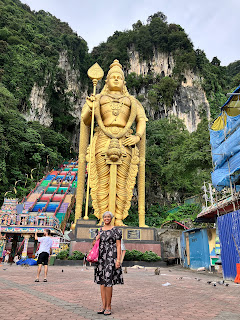Malaysia Trip (Dec 12-28, 2022)
One of my motivations for visiting Malaysia on this trip is because I’ve been researching possible places to retire as an expat and Malaysia and Portugal are always among the top 10 destinations on all the expat blogs. I’d already spent 3 weeks scouting possible retirement locales in Portugal this past July and so it was time to see if I could envision a life for myself in Malaysia.
While there is still more to explore in KL on my next trip, I didn’t care for Penang or southwestern Malaysia as longterm options. And I found that there are extremes in Malaysia - the ultra urban, business/tourist hubs, and the remote, rural towns which lack infrastructure and a modern vibe. I didn’t find a middle ground on this trip, a place where I could enjoy a slower pace away from tourists and still have the modern conveniences, multi-ethnic cuisine, and comfortable housing away from the high rise towers.
Hokken /Chinese and Tamilian) commingling. I did see green spaces between the skyscrapers but I question if city living away from a large body of water is my ideal scene. I have lived along the coast for too long. I think I could live comfortably near a lake or river so I need to explore those areas as well as the islands and eastern peninsular coastal cities on my next trip.
One thing I admire about the Malaysian gov’t is that they are actively protecting the interests of the local population by requiring that foreign investors buy homes worth at least 1 million MYR ($250K) or more. This preserves the affordable housing (particularly along the coast) for the Malaysian locals. If only the US had regulated this in Hawaii before the white mainlanders, Japanese and Chinese bought up all the Hawaiian coastline, leaving the local Hawaiian population displaced and bereft of their ancestral lands.
As expected, we experienced the Malay people as friendly, courteous and devoutly Muslim. We were struck by how many young Malay families we saw everywhere. It seems there’s been a population boom here and everyone has had babies in the last few years. The Muslim majority have very large families and my local guide here said this has allowed the Malays to overtake the Chinese that once dominated the local population.
The highlights for me on this trip were the cultural tours at Batu Caves (outside KL) and Kek Lok Si temple in Penang, where we were awestruck by the Buddhist and Hindu statuary, the colorful paper lanterns, and the scenic views over the rugged landscape. Also worthwhile was our visit to the former British “hill station” on Penang Hill. The Brits built hill stations al over SE Asia and the Indian subcontinent to escape the intense heat of the coastal areas. They literally fled to the hills to beat the heat.
There is a modern, high-speed funicular at the base of Penang Hill that takes you up to the top in 7 minutes (one way). On top, a mosque, a Hindu temple and a church sit side by side, overlooking gorgeous coastal and mountain views. There are a few simple eateries and minimal lodging, plus some tranquil hikes through the lush forest.
Temple monkeys (brown Macaques) congregate at the main tourist areas and can be quite persistent and aggressive. I had an upsetting run-in with a monkey at the Penang Botanical Garden who kept lunging for my ice cream, and I made a spectacle of myself shrieking and shooing him away. At the Batu Caves, a monkey slyly approached me from behind and cheekily slid my bag right off ny shoulder! I nearly fell down the steps in fright.
In the less touristed parts of Malaysia we found black Langor monkeys scrambling in the trees and along the telephone lines. They were quiet and shy compared to the temple monkeys and stayed out of reach. During the days we saw murders of crows and by night we watched flocks of fruit bats flit about, stealing small fruits from the tree outside our restaurant.
Unlike in India, there wasn’t a large population of stray dogs. The few we saw were well fed and cared for by the locals. At the Botanical Garden there were several strays wandering the kush acres and greeting the visitors at the entrance. This was nice to see and it made me realize that we rarely see digs in public places in the US unleashed they are leashed. We actually saw more stray cats here than dogs, many with bobbed tails and calico markings. As for other animals, we saw geckos and a large water monitor (a sizable green lizard), some yellow birds resembling orioles, along with little blue herons and white egrets.






Comments
Post a Comment
Thanks for visiting my blog!